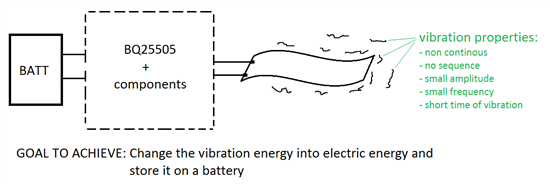Hello,
I read bq25505 datasheet, EVM datasheet also. I have few questions about bq2505 and how this IC works with piezoelectric element.
1. What AC/DC rectifier do you recommend for piezo energy harvesting application? Please take under consideration current and voltage losses on the rectifier. Could you please give an example of a small package rectifier?
2. What is the best way to make an rectifier that would lose as low power as possible? Is there a more efficient way that using schotkey diode or mosfets as rectifier?
Is it recommended to use zener diode after rectifier? Could you please give example of recommended zener diode that would have very small reverse (leakage) current under normal piezo energy harvesting operation?
3. Is there any requirement as far as protection on the input of the charger is considered?
Is there a solution (for example to use proper input capacitor) so that every piezo energy impulse (after every bend of piezoelectric) could be transferred to battery (charging battery)? For example, when piezoelectric is bended every 10-20 seconds, there is big power loss on the input side (input capacitor leakage, zener protection diode) between bends.
4. How to, using function generator, simulate piezoelectric input to energy harvesting module?
5. What exactly MPPT set for piezo application? From where get proper reference voltage?
Could you please give me an example of application using V_bat_ok signal to connect/disconnect load from charger?
6. What kind of batteries are available for V_STOR output? Which have the smallest leakage current?
Could you please give me example of low leakage ceramic capacitor?
7. What is and how to measure ionic contamination?
8. Is it possible to connect V_Ref_sample to ground in order to transfer whole current to charged battery?
I will be very glad for your help with this subject.




